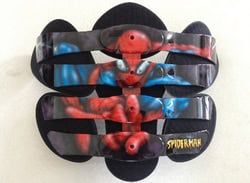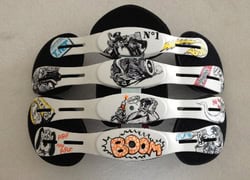Let’s Get It Clear: Appearance matters

Client compliance has often been a challenge for many clinicians. In this month’s article we look at some of the reasons for this, with a number of case studies illustrating examples of when a solution that has been set up in the clinic with every best intention, often falls apart in the real world. How well can we put ourselves into the positions of our clients, and enhance their endorsement of the solution?
Life is a real pain. Our clients do not sit in 90-90-90 text book positions, they are not symmetrical, their ‘comfortable’ lifestyle seated position can lead to increased skeletal deformity, they may not like the look of the equipment that we have prescribed which we know will benefit them, and their support staff haven’t been trained around the correct set-up and use of prescribed equipment, or, perhaps worse, the equipment is sitting in a corner unused.

Over and above this, there are circumstances back home which can never be anticipated in the clinic or showroom, or even when an assessment has been made in a person’s home. What can be done to improve this?
Gaining compliance
Having the client involved with the prescription process as much as possible is vital. With the ‘help’ of the internet many clients may be very well informed, and may have arrived having done quite a bit of research, and think they know what they want – or they have been long-term equipment users and have researched suitable solutions from their peer groups. This at least provides a base to work from although it may present different challenges!
The opposite is generally true, however. The majority of people who first meet a mobility challenge have no idea where to start. Through the NHS they may be pointed towards a wheelchair service, and then, depending on local policies, the individuals may or may not meet local criteria for equipment provision. At that point they are often unaware of personal wheelchair budgets, or of the possibility to top up their provision.
Indeed, at the recent UK Stroke Forum conference in Birmingham, one of the practicing physiotherapists whom I met was unaware of these options, so if NHS staff are unaware, what chance is there for the ‘man on the street’?
But appearance matters as well. Traditionally, many mobility devices used to be made principally of chrome covered steel. Things changed with the advent of aluminium frames, and some choice of colours. But still most ancillary equipment is predominantly black, or at least the chosen NHS provision is black to enable matching and recycling options. After years of persuading, Bodypoint now uses teal-coloured thread as a highlight colour on a number of their positioning products, which gives that extra touch of refinement (Figure 1).
Symmetric Designs offers different colours for the backs of their Apex head supports (Figure 2)1which provides an uplifting personalised highlight.
Another idea: for those with chest harnesses, how nice would it be if there were detachable covers, for example, to match the clothing choice of the day. Roho did offer a choice of colourful covers for their cushions at one time, but unfortunately these did not have a great take up, since this meant that dealers would need to carry increased inventory, and black was always going to be the ‘safe’ option.

Pimp my ride
‘Pimping up’ one’s chair is a way to get a product looking less like a disability device, and there are various options available. Wheel covers, such as Izzy Wheels’, have been one option (Figure 3)2. As quoted from a report in Vogue: “Izzy Wheels is bridging the gap between fashion and disability, all while armed with creativity and an inclusive message that’s hard not to be inspired by”.
Tarta has pioneered the opportunity for client choice from the start, by offering customers to have Tarta’s unique style of back supports supplied with customised finishes (Figure 4).
Other personalisation options have been tried (Figure 5)!

Can assessment tools help?
Pressure mapping can be a useful tool for gaining client understanding and acceptance. For a start, pressure mapping has been shown to provide better clinical outcomes. Data from a cushion study showed that on clinical judgement on its own, 21 per cent of the clients developed pressure ulcers, whereas pressure mapping combined with clinical judgement plus use of a pressure mapping device, only nine per cent developed ulcers3. In another study, in an ICU, with no use of pressure mapping: out of 320 patients: 16 developed Stage 2+ pressure ulcers. With the use of pressure mapping: out of 307 patients: only 1 developed a Stage 2+ pressure ulcer4.
At a meeting some years ago, I was discussing the use of pressure mapping with a group of female therapists from a leading US spinal injuries clinic. Their comment was that their clients (mainly men) tended not to be very compliant, but as soon as they showed their clients data from their seating evaluations with a pressure mapping system, the clients were much more compliant, since they believed what they saw on a computer screen much more than what they were being told!
In another situation, a wheelchair clinic had a client, a para, for whom they had supplied a top level ultralightweight manual chair, and top level cushion, but he still came back repeatedly to clinic with tissue damage on his buttocks. In desperation, they placed a pressure mapping device under his cushion and set it to take regular readings day and night. When he came back to the clinic, they found that between 8 and 11 each night there were no pressures showing, so they asked the client why. “Oh yeah. I go down to the pub every night, and leave my chair behind the bar, and sit on a bar stool with my mates.” I rest my case, m’lud.
Behaviours beyond our control
This case demonstrates an example of matters that we can not necessarily foresee or anticipate. Another couple of such cases were described by Filipe Monforte Correia during his autumn 2023 roadshow with BES Healthcare.
One case was that of a young girl in a wheelchair who at meal times was sitting in a strange position with her head twisted away from the midline, and it was therefore difficult to feed her – and this was not how she normally sat in the chair. Eventually someone realised that there was a television always on in the background almost, as a kind of wallpaper. This was being ignored by all the adults, but not by the girl who was twisting her head to a position where she could watch the screen. Her wheelchair position was moved to enable a clear view of the TV, and the problem was solved!
Another case was that of what was seen as a surly teenage lad for whom his updated chair and seating appeared to offer an excellent postural solution but his mother was devastated as he had apparently suddenly started slouching in his seat and hiding his head in his lap. It turned out that the trigger for this change of behaviour had been entirely unrelated to the updated seating solution, but a trip to the orthodontist! As part of the required intervention, a brace had been fitted: the youngster was very self aware of this change, and did not want people to see the brace. Gentle reassurance resolved the issue.
One needs to be aware that behaviour in the clinic may also not represent behaviour beyond the clinic. Many clients do strive to please their clinical adviser, and probably sit up in their chairs and seating systems ‘correctlt’ in the way they perceive their adviser wishes. While being pressure-mapped, if they can see the screen, they may try to adjust their posture to give the picture they think is required. This can be a valuable education tool, to show what happens if they move away from the optimal posture.
Conversely, a useful tip here is to go off and make a phone call or cup of coffee, and leave the client on their pressure mapping system for a while. The client will resort to the posture that they feel most comfortable with when on their own – legs crossed, arm hooked around the back of the chair, or whatever. Despite your best efforts in the clinic, this is what they will resort to when they leave, and so it’s useful to work with this posture while the client is in the clinic.

Appearance matters
What we’ve tried to address in this article is the importance of thinking outsidethe traditional box – client input and acceptance into solutions that can impact on short and long term acceptance. The principles of ‘Inclusive Design’ are important, and every effort should be made to avoid offering equipment that is assistive but where the design gives a visual ‘disability’ message.
When a solution created in the clinic does not work, what are the reasons? Is it that it was not suitable for their normal day-to-day activities for that client? Are there client-specific behavioural matters to be checked out?
Or is simply that the clients, or more specifically their carers, have had little or no education or training in how the prescribed equipment should be used – an all too common situation around the world5?
Reference
- https://www.symmetric-designs.com/apex-headrest-pads
- https://www.izzywheels.com/disney
- Allegretti A et al (2009) Pressure Ulcer Outcomes With and Without Use of Pressure Mapping 11th National NPUAP Biennial Conference pp6-7
- Siddiqui A et al (2013) A Continuous Bedside Pressure Mapping System for Prevention of Pressure Ulcer Development in the Medical ICU: A Retrospective Analysis. Wounds 25:333-339.
- Ter Haar MB Covering Mobility Needs in a Care Home. A Case Study. THIIS September 2023 pp38-39
Further items can be found at www.beshealthcare.net. If you are interested in receiving further information on the topic, please contact 
Dr Barend ter Haar has been involved in seating and mobility for over 30 years, including lecturing internationally and developing international seating standards.



